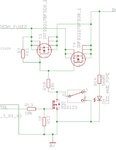skinny_c
Newbie level 3
Hi,
Ok - kind of analog question
I'm not an "analog" expert and only dabble in it when I have to, preferring to stick to microprocessors.
I have a 3.3v logic level from a microprocessor that I need to use to switch on/off a 5v 750mA supply to an external circuit. It doesn't have to be "fast" as I'm not pulsing the supply, just switching it on or off.
Using a MOSFET "seems" desirable - high current / small package.
From what I can see I need a "high" side as the "switch" is switching the 5v supply to a circuit, not the ground.
I've tried an Infineon BSS215P, but it's always "on" regardless of the logic level (0v or 3.3v) used to drive the gate. The logic drive to the gate is pulled high (3.3v) via a resistor and I can see that this is working correctly.
Ideally I need the MOSFET to be a single component solution and a SOT23 device. This will enable me to fit the device easily into the footprint of the demo board I'm using. I can accept a part that will handle 500mA if necessary, but 750mA would be ideal.
Having looked around on the net there's lots of talk about switch 12v power supplies from 5v but nothing I can find that covers what I'm trying to do. I've also seen people talking about using a transistor to drive the gate from the logic level, but I need to keep component counts low and board space is limited.
Any thoughts? It's driving me nuts!
Cheers,
C
Ok - kind of analog question
I'm not an "analog" expert and only dabble in it when I have to, preferring to stick to microprocessors.
I have a 3.3v logic level from a microprocessor that I need to use to switch on/off a 5v 750mA supply to an external circuit. It doesn't have to be "fast" as I'm not pulsing the supply, just switching it on or off.
Using a MOSFET "seems" desirable - high current / small package.
From what I can see I need a "high" side as the "switch" is switching the 5v supply to a circuit, not the ground.
I've tried an Infineon BSS215P, but it's always "on" regardless of the logic level (0v or 3.3v) used to drive the gate. The logic drive to the gate is pulled high (3.3v) via a resistor and I can see that this is working correctly.
Ideally I need the MOSFET to be a single component solution and a SOT23 device. This will enable me to fit the device easily into the footprint of the demo board I'm using. I can accept a part that will handle 500mA if necessary, but 750mA would be ideal.
Having looked around on the net there's lots of talk about switch 12v power supplies from 5v but nothing I can find that covers what I'm trying to do. I've also seen people talking about using a transistor to drive the gate from the logic level, but I need to keep component counts low and board space is limited.
Any thoughts? It's driving me nuts!
Cheers,
C
